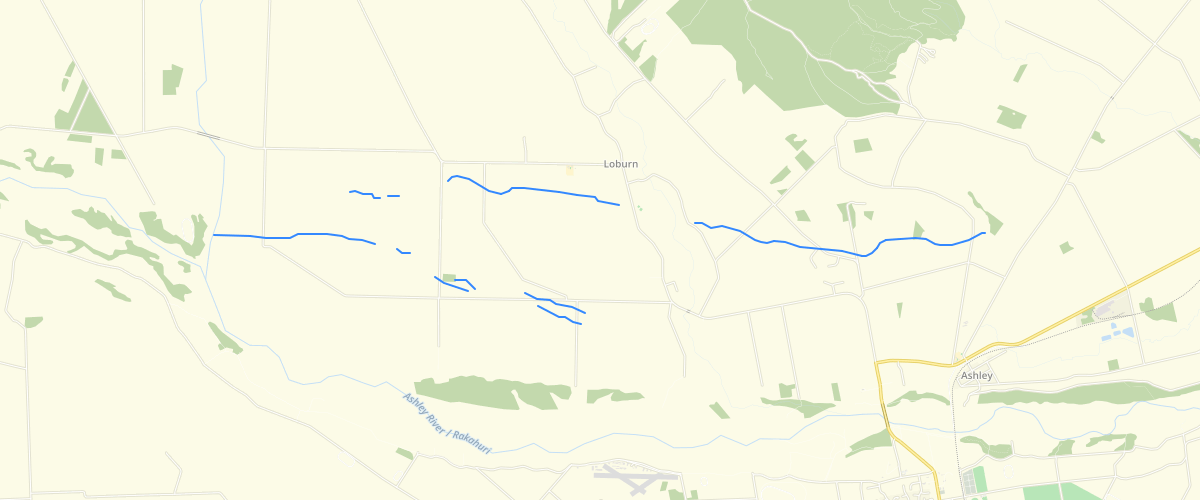Canterbury - Ashley Fault Zone Active Fault Lines 2014
Request AccessCanterbury - Ashley Fault Zone Active Fault Lines 2014 - There are eight main data fields. The first five are based directly on those from the GNS Science 1:250,000 scale geological map (QMAP) 'Faults' data structure. The last three are based directly on the Waimakariri District generalised active faults dataset (Barrell & Begg 2013; GNS Science Consultancy Report 2012/326; Environment Canterbury Report No. R13/28. This faults dataset supersedes that of Barrell & Begg (2013) in the area covered by this dataset.'ACCURACY' provides a qualitative indication with which the fault trace is mapped, via one of fourattributes; 'accurate' (fault trace is marked by a well defined surface scarp), 'approximate' (the fault trace lies somewhere in the general vicinty of the mapped line, but its exact location is uncertain), 'concealed' (any pre-existing fault scarp has been removed by erosion, or the fault trace has been buried beneath sediments that are younger than the most recent movement), 'inferred' (the presence of the fault is hypothesised based on various geological or landform considerations, but there is no direct evidence known for its actual presence at that location).'DOM_SENSE' is the estimated predominent sense of fault movement ('reverse', 'normal' or 'strike-slip').'SUB_SENSE' is the estimated subordinate sense of fault movement ('reverse', 'normal' or 'strike-slip').'DOWN_QUAD' is the directional quadrant towards which the fault displays relative down-throw, based on compass points N, S, E, W, or a combination of two adjacent directions.'SHAPE_LEN' is the length of the mapped line in metres.'WDC_name' is the assigned name of the fault feature, and corresponds to the names used in the Barrell & Begg (2013) dataset.'Certainty' indicates whether the fault represented by the line is 'definite', 'likely' or 'possible', as defined in the Barrell & Begg (2013) report.'Surf_form' provides an assessment of whether or not the fault represented by the line is 'well expressed', 'moderately expressed' or 'no expressed', as defined in the Barrell & Begg (2013) report.This dataset was compiled for presentation at a scale of 1:35,000 in the report, but the data were captured at more detailed scales.The lines representing the faults were mapped on-screen, at a scale of approximately 1:5,000. The locations of the fault lines where the fault is classified as 'well expressed' are considered to be accurate to +/- 10 m at best on the younger river terraces (Okuku Terrace 3/Makerikeri Terrace 2 and younger), but are no better than +/- 20 m on older terrace or hill landforms.There is lesser accuracy for lines that are classified as 'moderately expressed' or 'not expressed'. Users should obtain guidance from the Ground Deformation Classification map dataset as to the likely accuracy of the fault lines dataset coverage. Accuracy will be greatest close to mapped fault scarps, and increasingly less accurate the farther one is from a mapped scarp. Accompanying report is Barrell, D. J. A.; Van Dissen, R. J. 2014. Assessment of active fault ground deformation hazards associated with the Ashley Fault Zone, Loburn, North Canterbury, GNS Science Consultancy Report 2013/173 / Environment Canterbury Report No. R14/77.

Metadata
| Date | 10/09/2018 |
| License | CC BY 3.0 |
Sample Properties
- {} 16 keys▶
- "concealed"
- "reverse"
- "?dextral"
- "N"
- "Ashley Fault (west)"
- "likely"
- "not expressed"
- 1
- "MANCAP"
- 2
- "GNS Science"
- "2014-01-01T00:00:00.000Z"
- "GNS Science"
- "2014-01-01T00:00:00.000Z"
- 492.23398981
- 492.23398981373515
